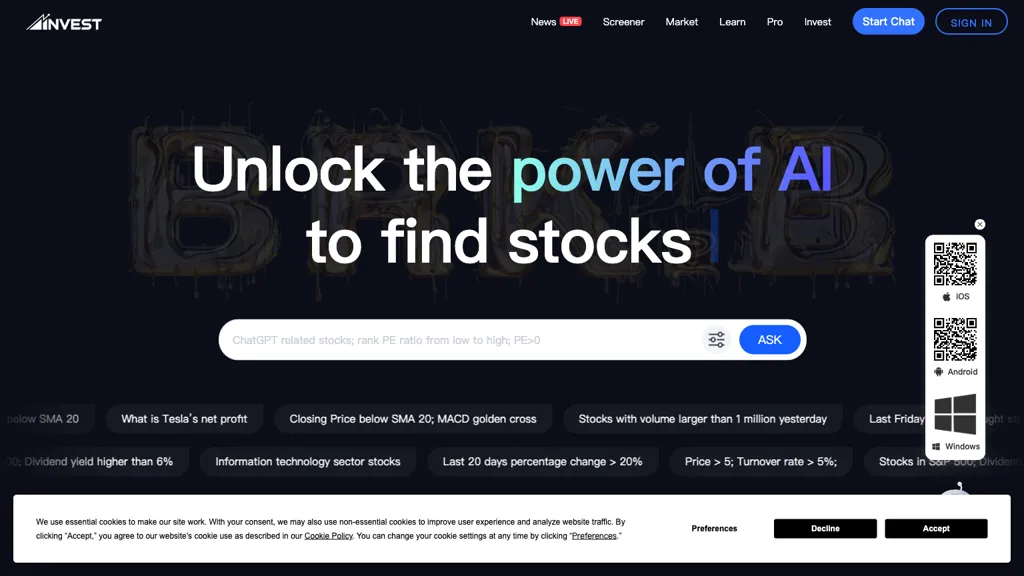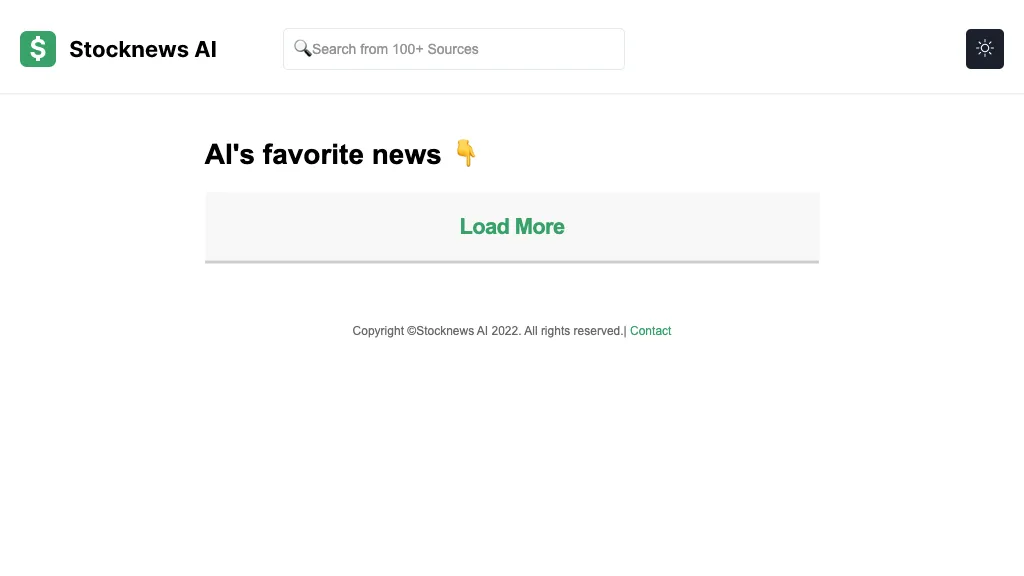Assessing the quality of the sources and data that are used by AI-driven stock prediction as well as trading platforms is crucial to ensure reliable and accurate information. A poor quality of data could lead to flawed predictions, financial losses, and a lack of trust of the platform. These are the top 10 tips to evaluate the quality of data and sources:
1. Verify the source of data
Be sure to verify the source: Ensure that the platform is using information from reliable sources (e.g. Bloomberg, Reuters Morningstar or exchanges such as NYSE and NASDAQ).
Transparency - The platform must be transparent about its data sources and update them regularly.
Avoid relying on a single source. Trustworthy platforms often combine data from several sources to minimize the chance of bias.
2. Examine the freshness of data
Real-time data as opposed to. delayed data Find out if your platform offers delayed or real-time data. Real-time data is essential to ensure that trading is active. However, data that is delayed can be adequate for long-term analytical purposes.
Update frequency: Examine the frequency with the time that data is being updated.
Accuracy of historical data Be sure the information is accurate and constant.
3. Evaluate Data Completeness
Find missing data: Check for gaps in historical data as well as tickers that are not working or insufficient financial statements.
Coverage - Make sure that the platform you select is able to cover all stocks, indices and markets that are relevant to your trading strategies.
Corporate actions: Check if the platform records dividends, stock splits mergers, and other corporate actions.
4. Accuracy of Test Data
Cross-verify your information: Verify the data on your platform against other trustworthy sources.
Error detection: Look for outliers, incorrect values or financial indicators that aren't matched.
Backtesting. Make use of historical data in order to test trading strategy and see whether it's in line with your expectations.
5. Review the Data Granularity
The level of detail: Make sure the platform is able to provide precise information, like intraday pricing volumes, bidding-asking spreads and order book depth.
Financial metrics: Determine if your platform offers detailed financial reports (income statement and balance sheet) along with important ratios like P/E/P/B/ROE. ).
6. Check for Data Cleansing and Preprocessing
Normalization of data is essential for ensuring consistency.
Outlier handling - Check how the platform handles anomalies and outliers.
Data imputation is not working: Find out whether the platform has reliable techniques to fill in gaps data points.
7. Evaluation of Data Consistency
Timezone alignment align data in accordance with the same timezone in order to prevent any discrepancies.
Format consistency: Make sure that the data is presented consistently (e.g. units, currency).
Cross-market compatibility: Make sure that the data from various exchanges and markets are in sync.
8. Assess Data Relevance
Relevance of data to trading strategy: Make sure the data is aligned with your style of trading.
Check the features of the platform.
Examine the integrity and security of your data
Data encryption: Ensure the platform has encryption in place to protect information during storage and transmission.
Tamper proofing: Ensure that the information on the platform is not being altered.
Conformity: Ensure that the platform meets regulations on data protection (e.g. GDPR, CCPA).
10. Transparency of the AI Model of the Platform is evaluated
Explainability: The platform must offer insight into how AI models employ data to make predictions.
Bias detection: Check if the platform actively monitors and corrects biases within the models or data.
Performance metrics. Examine performance metrics such as precision, accuracy, and recall to assess the reliability of the platform.
Bonus Tips:
User reviews and reputation User feedback and reviews to gauge the platform's reliability and data quality.
Trial period: You may try out the data quality and capabilities of a platform with the demo or trial before deciding to buy.
Support for customers - Check that the platform you choose to use is able to provide a solid customer service to address any data related issues.
Following these tips will enable you to analyze the data quality, source, and accuracy of AI-based stock prediction tools. Follow the top good about trading with ai for more info including investing ai, market ai, ai for investment, ai trading tools, ai for stock trading, investing ai, investment ai, chatgpt copyright, ai for investment, investment ai and more.

Top 10 Tips On How To Assess The Reputation Of Ai Stock Predicting/Analyzing Trading Platforms
To ensure reliability, trustworthiness and effectiveness, it is crucial to examine the reputation and reviews of AI-driven prediction platforms and trading platforms. Here are the top 10 tips to assess their reputation and review:
1. Check Independent Review Platforms
Reviews can be found on trusted platforms like G2, copyright or Capterra.
Why independent platforms provide unbiased feedback from actual users.
2. Analyze Case Studies and User Testimonials
Visit the platform's website to read user testimonials, case studies as well as other relevant information.
The reason: They offer insights into the performance of real-world applications, user satisfaction and other aspects.
3. Review of Expert Opinions, Industry Recognition
Tips: Check to see whether reputable publications, industry analysts and financial analysts have evaluated or recommended a particular platform.
Why: Expert endorsements add credibility to the platform's claims.
4. Social Media Sentiment
Tip: Monitor social media sites (e.g. Twitter. LinkedIn. Reddit.) to discover what people are talking about and what they think about it.
Why? Social media can be a fantastic source of honest opinions as well as information and trends about the platform.
5. Verify that you are in compliance with the regulatory requirements
Tip: Make sure the platform you use is compliant not just with privacy laws but also with financial regulations.
Why: Compliance is essential in order to make sure that the platform operates legally and ethically.
6. Transparency is essential in performance metrics
Tips: Find out if the platform has transparent performance metrics.
Transparency is essential because it builds trust, and lets users determine the efficacy of the platform.
7. Be aware of the quality of service provided by customers.
Review the platform to get information about their customer service.
Why is it important to have reliable support? It's crucial for resolving any issues and ensuring a pleasant customer experience.
8. Red Flags: Check reviews for red flags
TIP: Look out for complaints that have been repeated. They could be due to unsatisfactory performance, hidden costs or lack of updating.
Why? Consistently negative feedback can indicate potential problems in the system.
9. Evaluation of User Engagement and Community Engagement
Tips - See whether there's an active user community on the platform (e.g. Discord groups, forums) and also if they interact with their users regularly.
Why? A strong community indicates customer satisfaction and ongoing assistance.
10. Verify the track record of the company.
TIP: Study the company's history, leadership team, and past performances in the area of financial technology.
Why: A proven track record increases confidence in the platform's reliability and knowledge.
Compare Multiple Platforms
Compare the ratings and reputations of different platforms to determine which is best suited to your needs.
With these suggestions You can examine and evaluate the reputations and reviews of AI-based software for trading and stock prediction to ensure that you select the most reliable and effective solution. See the best can ai predict stock market hints for website advice including investing with ai, how to use ai for stock trading, best AI stocks to buy now, how to use ai for stock trading, ai options trading, chart ai trading, stock predictor, ai trading tool, AI stock investing, ai in stock market and more.
